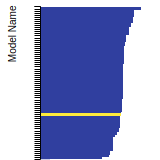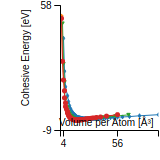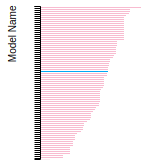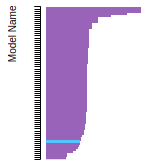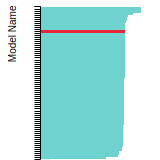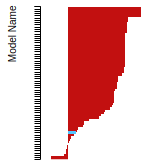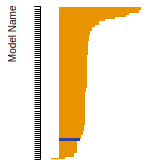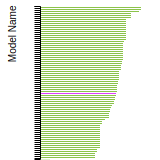 EAM_Dynamo_SturgeonLaird_2000_Al__MO_120808805541_005
EAM_Dynamo_SturgeonLaird_2000_Al__MO_120808805541_005
| Title
A single sentence description.
|
EAM potential (LAMMPS cubic hermite tabulation) for Al optimized for melting temperature developed by Sturgeon and Laird (2000) v005 |
|---|---|
| Description
A short description of the Model describing its key features including for example: type of model (pair potential, 3-body potential, EAM, etc.), modeled species (Ac, Ag, ..., Zr), intended purpose, origin, and so on.
|
This EAM model for Al is based on the model developed by Mei-Davenport, which we have optimized to give the correct experimental melting temperature. |
| Species
The supported atomic species.
| Al |
| Disclaimer
A statement of applicability provided by the contributor, informing users of the intended use of this KIM Item.
|
This model was developed as a prototype case for the Gibbs-Duhem protocol for optimizing melting points. As such, the melting point was the primary metric for its development. We have shown that the modifications to the original Mei-Davenport potential that we used to optimize T_m did not change the quality of the potential with respect to elastic constants, density, etc., but no systematic study of other properties was performed. |
| Content Origin | http://www.ctcms.nist.gov/potentials/Al.html |
| Contributor |
Ryan S. Elliott |
| Maintainer |
Ryan S. Elliott |
| Developer |
Jess B. Sturgeon Brian B. Laird |
| Published on KIM | 2018 |
| How to Cite | Click here to download this citation in BibTeX format. |
| Citations
This panel presents information regarding the papers that have cited the interatomic potential (IP) whose page you are on. The OpenKIM machine learning based Deep Citation framework is used to determine whether the citing article actually used the IP in computations (denoted by "USED") or only provides it as a background citation (denoted by "NOT USED"). For more details on Deep Citation and how to work with this panel, click the documentation link at the top of the panel. The word cloud to the right is generated from the abstracts of IP principle source(s) (given below in "How to Cite") and the citing articles that were determined to have used the IP in order to provide users with a quick sense of the types of physical phenomena to which this IP is applied. The bar chart shows the number of articles that cited the IP per year. Each bar is divided into green (articles that USED the IP) and blue (articles that did NOT USE the IP). Users are encouraged to correct Deep Citation errors in determination by clicking the speech icon next to a citing article and providing updated information. This will be integrated into the next Deep Citation learning cycle, which occurs on a regular basis. OpenKIM acknowledges the support of the Allen Institute for AI through the Semantic Scholar project for providing citation information and full text of articles when available, which are used to train the Deep Citation ML algorithm. |
This panel provides information on past usage of this interatomic potential (IP) powered by the OpenKIM Deep Citation framework. The word cloud indicates typical applications of the potential. The bar chart shows citations per year of this IP (bars are divided into articles that used the IP (green) and those that did not (blue)). The complete list of articles that cited this IP is provided below along with the Deep Citation determination on usage. See the Deep Citation documentation for more information. 
71 Citations (32 used)
Help us to determine which of the papers that cite this potential actually used it to perform calculations. If you know, click the .
USED (high confidence) Y. Wu, K. Zhang, J. Xiao, Y. Jiang, and L. Lv, “Conjugated bilayer structure of the homogeneous solid-liquid interface of metals.,” Physical chemistry chemical physics : PCCP. 2020. link Times cited: 1 Abstract: The concept of "interfacial region" has long preva… read more USED (high confidence) S. Subedi, L. Morrissey, S. M. Handrigan, and S. Nakhla, “The effect of many-body potential type and parameterisation on the accuracy of predicting mechanical properties of aluminium using molecular dynamics,” Molecular Simulation. 2020. link Times cited: 8 Abstract: ABSTRACT As opposed to traditional laboratory testing, Molec… read more USED (high confidence) N. Nenuwe, E. Agbalagba, and E. Enaibe, “Comparative study of thermophysical properties of Nickel in liquid phase,” Ruhuna Journal of Science. 2018. link Times cited: 1 Abstract: The results of molecular dynamics simulations of the self-di… read more USED (high confidence) O. Nenuwe and O. Osafile, “Temperature dependence of Self-diffusion coefficient (SDC) of liquid aluminum using Embedded Atom Method-Finnis-Sinclair (EAMFS) potential,” Journal of Applied Sciences and Environmental Management. 2018. link Times cited: 1 Abstract: Atomistix tool kit force field calculations have been done, … read more USED (high confidence) V. Warshavsky and X. Song, “Perturbation theory for solid–liquid interfacial free energies,” Journal of Physics: Condensed Matter. 2010. link Times cited: 8 Abstract: A perturbation theory is developed to calculate solid–liquid… read more USED (high confidence) S. Namilae, B. Radhakrishnan, and J. R. Morris, “Atomistic simulation of the effect of Ga on crack tip opening in Al bicrystals,” Modelling and Simulation in Materials Science and Engineering. 2008. link Times cited: 6 Abstract: Liquid metal embrittlement (LME) in the Al–Ga system is stud… read more USED (high confidence) P. Piaggi, “Entropy as a tool for crystal discovery.” 2019. link Times cited: 1 Abstract: The computational prediction of crystal structures has emerg… read more USED (low confidence) B. Waters, D. S. Karls, I. Nikiforov, R. Elliott, E. Tadmor, and B. Runnels, “Automated determination of grain boundary energy and potential-dependence using the OpenKIM framework,” Computational Materials Science. 2022. link Times cited: 5 USED (low confidence) S. Ahmad, T. Brink, C. Liebscher, and G. Dehm, “Microstates and defects of incoherent Σ3 [111] twin boundaries in aluminum,” Acta Materialia. 2022. link Times cited: 4 USED (low confidence) T. Zhou, Y. Wu, and J. You, “The embedded-seed-method molecular dynamics simulation of the crystallization of Al and the influence of the artificial initial stress,” Journal of Crystal Growth. 2022. link Times cited: 0 USED (low confidence) J. Gabriel et al., “Bayesian Automated Weighting of Aggregated DFT, MD, and Experimental Data for Candidate Thermodynamic Models of Aluminum with Uncertainty Quantification,” Materialia. 2021. link Times cited: 2 USED (low confidence) L.-F. Zhu, J. Janssen, S. Ishibashi, F. Körmann, B. Grabowski, and J. Neugebauer, “A fully automated approach to calculate the melting temperature of elemental crystals,” Computational Materials Science. 2021. link Times cited: 17 USED (low confidence) R. Yan et al., “Structural and mechanical properties of homogeneous solid-liquid interface of Al modelled with COMB3 potential,” Computational Materials Science. 2018. link Times cited: 9 USED (low confidence) H. N. Pishkenari, F. S. Yousefi, and A. Taghibakhshi, “Determination of surface properties and elastic constants of FCC metals: a comparison among different EAM potentials in thin film and bulk scale,” Materials Research Express. 2018. link Times cited: 22 Abstract: Three independent elastic constants C11, C12, and C44 were c… read more USED (low confidence) J. Shao, A. He, and P. Wang, “Atomistic simulations on the dynamic properties of shock and release melting in single crystal Al,” Computational Materials Science. 2018. link Times cited: 12 USED (low confidence) M. Mendelev et al., “Molecular dynamics simulation of the solid-liquid interface migration in terbium.,” The Journal of chemical physics. 2018. link Times cited: 16 Abstract: We developed a Tb embedded atom method potential which prope… read more USED (low confidence) Y. Jiang, L. Lv, and Y. Wu, “Solid-Liquid Phase Transitions of FCC-Al and HCP-Mg Nanoparticles.” 2016. link Times cited: 1 USED (low confidence) E. S. Wise, M. Liu, and T. Miller, “Sputtering of cubic metal crystals by low-energy xenon-ions,” Computational Materials Science. 2015. link Times cited: 5 USED (low confidence) S. Kalidindi, J. A. Gomberg, Z. Trautt, and C. Becker, “Application of data science tools to quantify and distinguish between structures and models in molecular dynamics datasets,” Nanotechnology. 2015. link Times cited: 39 Abstract: Structure quantification is key to successful mining and ext… read more USED (low confidence) Y. Wu, R.-B. Li, J. Xiao, and Y. Jiang, “Crystallization in Supercooled BCC-Vanadium, HCP-Zinc and FCC-Aluminum.” 2015. link Times cited: 0 USED (low confidence) Y. Sun, W. Sun, Y. Fu, F. Wang, Y. Gao, and J.-wei Zhao, “The deformation behaviors of silver nanowires including 3D defects under tension,” Computational Materials Science. 2013. link Times cited: 7 USED (low confidence) W. Luo, W. Hu, K. Su, and F. Liu, “The calculation of surface free energy based on embedded atom method for solid nickel,” Applied Surface Science. 2013. link Times cited: 27 USED (low confidence) W. Luo, W. Hu, S. Xiao, H. Deng, and F. Gao, “Phase transition in nanocrystalline iron: Atomistic-level simulations,” International Journal of Materials Research. 2010. link Times cited: 5 Abstract: Molecular dynamics simulations, along with the modified anal… read more USED (low confidence) J. R. Morris, M. Mendelev, and D. Srolovitz, “A comparison of crystal-melt interfacial free energies using different Al potentials,” Journal of Non-crystalline Solids. 2007. link Times cited: 23 USED (low confidence) H. Nam and D. Srolovitz, “Molecular dynamics simulation of Ga penetration along Σ5 symmetric tilt grain boundaries in an Al bicrystal,” Physical Review B. 2007. link Times cited: 31 Abstract: Liquid metal embrittlement (LME) is a common feature of syst… read more USED (low confidence) M. Amini and B. Laird, “Kinetic coefficient for hard-sphere crystal growth from the melt.,” Physical review letters. 2006. link Times cited: 62 Abstract: Using molecular-dynamics simulation, we determine the magnit… read more USED (low confidence) K. Moriguchi and M. Igarashi, “Correlation between lattice-strain energetics and melting properties: Molecular dynamics and lattice dynamics using EAM models of Al,” Physical Review B. 2006. link Times cited: 14 USED (low confidence) B. F. Nicholson, P. Clancy, and S. Rick, “The interface response function and melting point of the prism interface of ice Ih using a fluctuating charge model (TIP4P-FQ),” Journal of Crystal Growth. 2006. link Times cited: 22 USED (low confidence) D. Sun et al., “Crystal-melt interfacial free energies in hcp metals: A molecular dynamics study of Mg,” Physical Review B. 2006. link Times cited: 327 Abstract: Crystal-melt interfacial free energies $(\ensuremath{\gamma}… read more USED (low confidence) X. Song and J. R. Morris, “Accurate method to calculate liquid and solid free energies for embedded atom potentials,” Physical Review B. 2003. link Times cited: 26 Abstract: Using a perturbation theory with a hard-sphere reference sys… read more USED (low confidence) E. Ogando, M. Caro, and A. Caro, “Reference systems for computational free energy calculations of binary solutions: role of the constrained center of mass motion,” Computational Materials Science. 2002. link Times cited: 7 USED (low confidence) R. Aga and J. R. Morris, “Modeling: The Role Of Atomistic Simulations.” 2008. link Times cited: 1 NOT USED (low confidence) P. Piaggi and M. Parrinello, “Entropy based fingerprint for local crystalline order.,” The Journal of chemical physics. 2017. link Times cited: 87 Abstract: We introduce a new fingerprint that allows distinguishing be… read more NOT USED (low confidence) Z. Trautt, F. Tavazza, and C. Becker, “Facilitating the selection and creation of accurate interatomic potentials with robust tools and characterization,” Modelling and Simulation in Materials Science and Engineering. 2015. link Times cited: 14 Abstract: The Materials Genome Initiative seeks to significantly decre… read more NOT USED (low confidence) Y. Liu and J.-wei Zhao, “The size dependence of the mechanical properties and breaking behavior of metallic nanowires: A statistical description,” Computational Materials Science. 2011. link Times cited: 20 NOT USED (low confidence) Y. Liu, F. Wang, J.-wei Zhao, L. Jiang, M. Kiguchi, and K. Murakoshi, “Theoretical investigation on the influence of temperature and crystallographic orientation on the breaking behavior of copper nanowire.,” Physical chemistry chemical physics : PCCP. 2009. link Times cited: 36 Abstract: In this paper, molecular dynamics simulations have been cond… read more NOT USED (low confidence) J. R. Morris, U. Dahlborg, and M. Calvo-Dahlborg, “Recent developments and outstanding challenges in theory and modeling of liquid metals,” Journal of Non-crystalline Solids. 2007. link Times cited: 23 NOT USED (low confidence) C. Vega, M. Martín-Conde, and A. Patrykiejew, “Absence of superheating for ice Ih with a free surface: a new method of determining the melting point of different water models,” Molecular Physics. 2006. link Times cited: 58 Abstract: Molecular dynamic simulations were performed for ice Ih with… read more NOT USED (low confidence) J. L. Abascal, R. Fernández, C. Vega, and M. Carignano, “The melting temperature of the six site potential model of water.,” The Journal of chemical physics. 2006. link Times cited: 64 Abstract: The melting temperature of the six site potential of water i… read more NOT USED (low confidence) E. Arregui, M. Caro, and A. Caro, “Numerical evaluation of the exact phase diagram of an empirical Hamiltonian: Embedded atom model for the Au-Ni system,” Physical Review B. 2002. link Times cited: 34 Abstract: Molecular-dynamics simulations were used to calculate the Gi… read more NOT USED (low confidence) A. Ovrutsky, A. Prokhoda, and M. Rasshchupkyna, “Simulation Techniques for Atomic Systems.” 2014. link Times cited: 3 NOT USED (high confidence) D. R. Pratt, L. Morrissey, and S. Nakhla, “Molecular dynamics simulations of nanoindentation – the importance of force field choice on the predicted elastic modulus of FCC aluminum,” Molecular Simulation. 2020. link Times cited: 5 Abstract: ABSTRACT Molecular Dynamics (MD) was used to determine the a… read more NOT USED (high confidence) S. Kavousi, B. R. Novak, M. Baskes, M. A. Zaeem, and D. Moldovan, “Modified embedded-atom method potential for high-temperature crystal-melt properties of Ti–Ni alloys and its application to phase field simulation of solidification,” Modelling and Simulation in Materials Science and Engineering. 2019. link Times cited: 21 Abstract: We developed new interatomic potentials, based on the second… read more NOT USED (high confidence) L. Wu et al., “Calculation of solid–liquid interfacial free energy and its anisotropy in undercooled system,” Rare Metals. 2018. link Times cited: 6 NOT USED (high confidence) L. Hale, “Comparing Modeling Predictions of Aluminum Edge Dislocations: Semidiscrete Variational Peierls–Nabarro Versus Atomistics,” JOM. 2018. link Times cited: 7 NOT USED (high confidence) Y. Jiang, J. Luo, and Y. Wu, “The validation and preference among different EAM potentials to describe the solid–liquid transition of aluminum,” Modelling and Simulation in Materials Science and Engineering. 2017. link Times cited: 6 Abstract: Empirical potential is vital to the classic atomic simulatio… read more NOT USED (high confidence) M. Mendelev, T. L. Underwood, and G. Ackland, “Development of an interatomic potential for the simulation of defects, plasticity, and phase transformations in titanium.,” The Journal of chemical physics. 2016. link Times cited: 122 Abstract: New interatomic potentials describing defects, plasticity, a… read more NOT USED (high confidence) N. Admal, J. Marian, and G. Po, “The atomistic representation of first strain-gradient elastic tensors,” Journal of The Mechanics and Physics of Solids. 2016. link Times cited: 36 NOT USED (high confidence) S. Wilson and M. Mendelev, “A unified relation for the solid-liquid interface free energy of pure FCC, BCC, and HCP metals.,” The Journal of chemical physics. 2016. link Times cited: 37 Abstract: We study correlations between the solid-liquid interface (SL… read more NOT USED (high confidence) L. Wu, B. Xu, Q. Li, W. Liu, and M. Li, “Anisotropic crystal–melt interfacial energy and stiffness of aluminum,” Journal of Materials Research. 2015. link Times cited: 21 Abstract: The crystal–melt interfacial free energy is an important qua… read more NOT USED (high confidence) S. Wilson and M. Mendelev, “Anisotropy of the solid–liquid interface properties of the Ni–Zr B33 phase from molecular dynamics simulation,” Philosophical Magazine. 2015. link Times cited: 58 Abstract: Solid–liquid interface (SLI) properties of the Ni–Zr B33 pha… read more NOT USED (high confidence) V. Thapar and F. Escobedo, “Extensions of the interfacial pinning method and application to hard core systems.,” The Journal of chemical physics. 2014. link Times cited: 13 Abstract: The precise estimation of the location of phase transitions … read more NOT USED (high confidence) S. Wilson and M. Mendelev, “Dependence of solid–liquid interface free energy on liquid structure,” Modelling and Simulation in Materials Science and Engineering. 2014. link Times cited: 17 Abstract: The Turnbull relation is widely believed to enable predictio… read more NOT USED (high confidence) J. R. Espinosa, E. Sanz, C. Valeriani, and C. Vega, “On fluid-solid direct coexistence simulations: the pseudo-hard sphere model.,” The Journal of chemical physics. 2013. link Times cited: 78 Abstract: We investigate methodological issues concerning the direct c… read more NOT USED (high confidence) L. Wang and A. van de Walle, “Ab initio calculations of the melting temperatures of refractory bcc metals.,” Physical chemistry chemical physics : PCCP. 2012. link Times cited: 13 Abstract: We present ab initio calculations of the melting temperature… read more NOT USED (high confidence) C. Becker and M. J. Kramer, “Atomistic comparison of volume-dependent melt properties from four models of aluminum,” Modelling and Simulation in Materials Science and Engineering. 2010. link Times cited: 30 Abstract: With the increasing use of simulations in materials research… read more NOT USED (high confidence) H. Akbarzadeh, H. Abroshan, and G. Parsafar, “Surface free energy of platinum nanoparticles at zero pressure: A molecular dynamic study,” Solid State Communications. 2010. link Times cited: 13 NOT USED (high confidence) M. Mendelev, M. Asta, M. J. Rahman, and J. Hoyt, “Development of interatomic potentials appropriate for simulation of solid–liquid interface properties in Al–Mg alloys,” Philosophical Magazine. 2009. link Times cited: 126 Abstract: Different approaches are analyzed for construction of semi-e… read more NOT USED (high confidence) M. Mendelev, M. Kramer, R. Ott, D. Sordelet, D. Yagodin, and P. Popel,’ “Development of suitable interatomic potentials for simulation of liquid and amorphous Cu–Zr alloys,” Philosophical Magazine. 2009. link Times cited: 334 Abstract: We present a new semi-empirical potential suitable for molec… read more NOT USED (high confidence) M. Mendelev, M. Kramer, C. Becker, and M. Asta, “Analysis of semi-empirical interatomic potentials appropriate for simulation of crystalline and liquid Al and Cu,” Philosophical Magazine. 2008. link Times cited: 365 Abstract: We investigate the application of embedded atom method (EAM)… read more NOT USED (high confidence) C. Vega, E. Sanz, J. L. Abascal, and E. Noya, “Determination of phase diagrams via computer simulation: methodology and applications to water, electrolytes and proteins,” Journal of Physics: Condensed Matter. 2008. link Times cited: 229 Abstract: In this review we focus on the determination of phase diagra… read more NOT USED (high confidence) W. Luo, W. Hu, and S. Xiao, “Melting temperature of Pb nanostructural materials from free energy calculation.,” The Journal of chemical physics. 2008. link Times cited: 22 Abstract: The thermodynamic properties of lead, including the entropy,… read more NOT USED (high confidence) W. Luo, W. Hu, and S. Xiao, “Size Effect on the Thermodynamic Properties of Silver Nanoparticles,” Journal of Physical Chemistry C. 2008. link Times cited: 186 Abstract: The Gibbs free energy of silver nanoparticles has been obtai… read more NOT USED (high confidence) M. Mendelev and G. Ackland, “Development of an interatomic potential for the simulation of phase transformations in zirconium,” Philosophical Magazine Letters. 2007. link Times cited: 266 Abstract: In recent years, some 30 studies have been published on the … read more NOT USED (high confidence) C. Vega, J. L. Abascal, and I. Nezbeda, “Vapor-liquid equilibria from the triple point up to the critical point for the new generation of TIP4P-like models: TIP4P/Ew, TIP4P/2005, and TIP4P/ice.,” The Journal of chemical physics. 2006. link Times cited: 201 Abstract: The vapor-liquid equilibria of three recently proposed water… read more NOT USED (high confidence) X.-bing Feng and B. B. L. *, “A 6-site force field for succinonitrile,” Molecular Physics. 2005. link Times cited: 4 Abstract: A 6-site succinonitrile force field has been developed. The … read more NOT USED (high confidence) M. Mendelev, S. Han, D. Srolovitz, G. Ackland, D. Sun, and M. Asta, “Development of new interatomic potentials appropriate for crystalline and liquid iron,” Philosophical Magazine. 2003. link Times cited: 1093 Abstract: Two procedures were developed to fit interatomic potentials … read more NOT USED (high confidence) J. Hoyt, M. Asta, and A. Karma, “Atomistic and continuum modeling of dendritic solidification,” Materials Science & Engineering R-reports. 2003. link Times cited: 332 NOT USED (high confidence) M. Koning, A. Antonelli, and S. Yip, “Single-simulation determination of phase boundaries: A dynamic Clausius–Clapeyron integration method,” Journal of Chemical Physics. 2001. link Times cited: 44 Abstract: We present a dynamic implementation of the Clausius–Clapeyro… read more NOT USED (high confidence) D. Alfé, M. Gillan, and G. D. Price, “Complementary approaches to the ab initio calculation of melting properties,” Journal of Chemical Physics. 2001. link Times cited: 79 Abstract: Several research groups have recently reported ab initio cal… read more NOT USED (high confidence) M. Jia, Y. Lai, Z. Tian, and Y.-xiang Liu, “Calculation of the surface free energy of fcc copper nanoparticles,” Modelling and Simulation in Materials Science and Engineering. 2008. link Times cited: 31 Abstract: Using molecular dynamics simulations with the modified analy… read more |
| Funding | Not available |
| Short KIM ID
The unique KIM identifier code.
| MO_120808805541_005 |
| Extended KIM ID
The long form of the KIM ID including a human readable prefix (100 characters max), two underscores, and the Short KIM ID. Extended KIM IDs can only contain alpha-numeric characters (letters and digits) and underscores and must begin with a letter.
| EAM_Dynamo_SturgeonLaird_2000_Al__MO_120808805541_005 |
| DOI |
10.25950/d62edb43 https://doi.org/10.25950/d62edb43 https://commons.datacite.org/doi.org/10.25950/d62edb43 |
| KIM Item Type
Specifies whether this is a Portable Model (software implementation of an interatomic model); Portable Model with parameter file (parameter file to be read in by a Model Driver); Model Driver (software implementation of an interatomic model that reads in parameters).
| Portable Model using Model Driver EAM_Dynamo__MD_120291908751_005 |
| Driver | EAM_Dynamo__MD_120291908751_005 |
| KIM API Version | 2.0 |
| Potential Type | eam |
| Programming Language(s)
The programming languages used in the code and the percentage of the code written in each one. "N/A" means "not applicable" and refers to model parameterizations which only include parameter tables and have no programming language.
| N/A |
| Previous Version | EAM_Dynamo_SturgeonLaird_2000_Al__MO_120808805541_004 |
| Grade | Name | Category | Brief Description | Full Results | Aux File(s) |
|---|---|---|---|---|---|
| P | vc-species-supported-as-stated | mandatory | The model supports all species it claims to support; see full description. |
Results | Files |
| P | vc-periodicity-support | mandatory | Periodic boundary conditions are handled correctly; see full description. |
Results | Files |
| P | vc-permutation-symmetry | mandatory | Total energy and forces are unchanged when swapping atoms of the same species; see full description. |
Results | Files |
| B | vc-forces-numerical-derivative | consistency | Forces computed by the model agree with numerical derivatives of the energy; see full description. |
Results | Files |
| F | vc-dimer-continuity-c1 | informational | The energy versus separation relation of a pair of atoms is C1 continuous (i.e. the function and its first derivative are continuous); see full description. |
Results | Files |
| P | vc-objectivity | informational | Total energy is unchanged and forces transform correctly under rigid-body translation and rotation; see full description. |
Results | Files |
| P | vc-inversion-symmetry | informational | Total energy is unchanged and forces change sign when inverting a configuration through the origin; see full description. |
Results | Files |
| P | vc-memory-leak | informational | The model code does not have memory leaks (i.e. it releases all allocated memory at the end); see full description. |
Results | Files |
| P | vc-thread-safe | mandatory | The model returns the same energy and forces when computed in serial and when using parallel threads for a set of configurations. Note that this is not a guarantee of thread safety; see full description. |
Results | Files |
| P | vc-unit-conversion | mandatory | The model is able to correctly convert its energy and/or forces to different unit sets; see full description. |
Results | Files |
BCC Lattice Constant
This bar chart plot shows the mono-atomic body-centered cubic (bcc) lattice constant predicted by the current model (shown in the unique color) compared with the predictions for all other models in the OpenKIM Repository that support the species. The vertical bars show the average and standard deviation (one sigma) bounds for all model predictions. Graphs are generated for each species supported by the model.
Cohesive Energy Graph
This graph shows the cohesive energy versus volume-per-atom for the current mode for four mono-atomic cubic phases (body-centered cubic (bcc), face-centered cubic (fcc), simple cubic (sc), and diamond). The curve with the lowest minimum is the ground state of the crystal if stable. (The crystal structure is enforced in these calculations, so the phase may not be stable.) Graphs are generated for each species supported by the model.
Diamond Lattice Constant
This bar chart plot shows the mono-atomic face-centered diamond lattice constant predicted by the current model (shown in the unique color) compared with the predictions for all other models in the OpenKIM Repository that support the species. The vertical bars show the average and standard deviation (one sigma) bounds for all model predictions. Graphs are generated for each species supported by the model.
Dislocation Core Energies
This graph shows the dislocation core energy of a cubic crystal at zero temperature and pressure for a specific set of dislocation core cutoff radii. After obtaining the total energy of the system from conjugate gradient minimizations, non-singular, isotropic and anisotropic elasticity are applied to obtain the dislocation core energy for each of these supercells with different dipole distances. Graphs are generated for each species supported by the model.
(No matching species)FCC Elastic Constants
This bar chart plot shows the mono-atomic face-centered cubic (fcc) elastic constants predicted by the current model (shown in blue) compared with the predictions for all other models in the OpenKIM Repository that support the species. The vertical bars show the average and standard deviation (one sigma) bounds for all model predictions. Graphs are generated for each species supported by the model.
FCC Lattice Constant
This bar chart plot shows the mono-atomic face-centered cubic (fcc) lattice constant predicted by the current model (shown in red) compared with the predictions for all other models in the OpenKIM Repository that support the species. The vertical bars show the average and standard deviation (one sigma) bounds for all model predictions. Graphs are generated for each species supported by the model.
FCC Stacking Fault Energies
This bar chart plot shows the intrinsic and extrinsic stacking fault energies as well as the unstable stacking and unstable twinning energies for face-centered cubic (fcc) predicted by the current model (shown in blue) compared with the predictions for all other models in the OpenKIM Repository that support the species. The vertical bars show the average and standard deviation (one sigma) bounds for all model predictions. Graphs are generated for each species supported by the model.
FCC Surface Energies
This bar chart plot shows the mono-atomic face-centered cubic (fcc) relaxed surface energies predicted by the current model (shown in blue) compared with the predictions for all other models in the OpenKIM Repository that support the species. The vertical bars show the average and standard deviation (one sigma) bounds for all model predictions. Graphs are generated for each species supported by the model.
SC Lattice Constant
This bar chart plot shows the mono-atomic simple cubic (sc) lattice constant predicted by the current model (shown in the unique color) compared with the predictions for all other models in the OpenKIM Repository that support the species. The vertical bars show the average and standard deviation (one sigma) bounds for all model predictions. Graphs are generated for each species supported by the model.
Cubic Crystal Basic Properties Table
Species: AlDisclaimer From Model Developer
This model was developed as a prototype case for the Gibbs-Duhem protocol for optimizing melting points. As such, the melting point was the primary metric for its development. We have shown that the modifications to the original Mei-Davenport potential that we used to optimize T_m did not change the quality of the potential with respect to elastic constants, density, etc., but no systematic study of other properties was performed.
Creators:
Contributor: karls
Publication Year: 2019
DOI: https://doi.org/10.25950/64cb38c5
This Test Driver uses LAMMPS to compute the cohesive energy of a given monoatomic cubic lattice (fcc, bcc, sc, or diamond) at a variety of lattice spacings. The lattice spacings range from a_min (=a_min_frac*a_0) to a_max (=a_max_frac*a_0) where a_0, a_min_frac, and a_max_frac are read from stdin (a_0 is typically approximately equal to the equilibrium lattice constant). The precise scaling and number of lattice spacings sampled between a_min and a_0 (a_0 and a_max) is specified by two additional parameters passed from stdin: N_lower and samplespacing_lower (N_upper and samplespacing_upper). Please see README.txt for further details.
| Test | Test Results | Link to Test Results page | Benchmark time
Usertime multiplied by the Whetstone Benchmark. This number can be used (approximately) to compare the performance of different models independently of the architecture on which the test was run.
Measured in Millions of Whetstone Instructions (MWI) |
|---|---|---|---|
| Cohesive energy versus lattice constant curve for bcc Al v004 | view | 7450 | |
| Cohesive energy versus lattice constant curve for diamond Al v004 | view | 7648 | |
| Cohesive energy versus lattice constant curve for fcc Al v004 | view | 7718 | |
| Cohesive energy versus lattice constant curve for sc Al v004 | view | 11480 |
Creators: Junhao Li and Ellad Tadmor
Contributor: tadmor
Publication Year: 2019
DOI: https://doi.org/10.25950/5853fb8f
Computes the cubic elastic constants for some common crystal types (fcc, bcc, sc, diamond) by calculating the hessian of the energy density with respect to strain. An estimate of the error associated with the numerical differentiation performed is reported.
| Test | Test Results | Link to Test Results page | Benchmark time
Usertime multiplied by the Whetstone Benchmark. This number can be used (approximately) to compare the performance of different models independently of the architecture on which the test was run.
Measured in Millions of Whetstone Instructions (MWI) |
|---|---|---|---|
| Elastic constants for bcc Al at zero temperature v006 | view | 2079 | |
| Elastic constants for diamond Al at zero temperature v001 | view | 3903 | |
| Elastic constants for fcc Al at zero temperature v006 | view | 2239 | |
| Elastic constants for sc Al at zero temperature v006 | view | 1440 |
Creators: Junhao Li
Contributor: jl2922
Publication Year: 2019
DOI: https://doi.org/10.25950/d794c746
Computes the elastic constants for hcp crystals by calculating the hessian of the energy density with respect to strain. An estimate of the error associated with the numerical differentiation performed is reported.
| Test | Test Results | Link to Test Results page | Benchmark time
Usertime multiplied by the Whetstone Benchmark. This number can be used (approximately) to compare the performance of different models independently of the architecture on which the test was run.
Measured in Millions of Whetstone Instructions (MWI) |
|---|---|---|---|
| Elastic constants for hcp Al at zero temperature v004 | view | 1242 |
Creators:
Contributor: ilia
Publication Year: 2025
DOI: https://doi.org/10.25950/866c7cfa
Computes the equilibrium crystal structure and energy for an arbitrary crystal at zero temperature and applied stress by performing symmetry-constrained relaxation. The crystal structure is specified using the AFLOW prototype designation. Multiple sets of free parameters corresponding to the crystal prototype may be specified as initial guesses for structure optimization. No guarantee is made regarding the stability of computed equilibria, nor that any are the ground state.
| Test | Test Results | Link to Test Results page | Benchmark time
Usertime multiplied by the Whetstone Benchmark. This number can be used (approximately) to compare the performance of different models independently of the architecture on which the test was run.
Measured in Millions of Whetstone Instructions (MWI) |
|---|---|---|---|
| Equilibrium crystal structure and energy for Al in AFLOW crystal prototype A_cF4_225_a v003 | view | 176715 | |
| Equilibrium crystal structure and energy for Al in AFLOW crystal prototype A_cI2_229_a v003 | view | 218912 |
Creators:
Contributor: brunnels
Publication Year: 2022
DOI: https://doi.org/10.25950/2c59c9d6
Computes grain boundary energy for a range of tilt angles given a crystal structure, tilt axis, and material.
| Test | Test Results | Link to Test Results page | Benchmark time
Usertime multiplied by the Whetstone Benchmark. This number can be used (approximately) to compare the performance of different models independently of the architecture on which the test was run.
Measured in Millions of Whetstone Instructions (MWI) |
|---|---|---|---|
| Relaxed energy as a function of tilt angle for a 100 symmetric tilt grain boundary in fcc Al v003 | view | 4345020 | |
| Relaxed energy as a function of tilt angle for a 110 symmetric tilt grain boundary in fcc Al v001 | view | 22046463 | |
| Relaxed energy as a function of tilt angle for a 111 symmetric tilt grain boundary in fcc Al v001 | view | 7584720 | |
| Relaxed energy as a function of tilt angle for a 112 symmetric tilt grain boundary in fcc Al v001 | view | 44072351 |
Creators: Daniel S. Karls and Junhao Li
Contributor: karls
Publication Year: 2019
DOI: https://doi.org/10.25950/2765e3bf
Equilibrium lattice constant and cohesive energy of a cubic lattice at zero temperature and pressure.
| Test | Test Results | Link to Test Results page | Benchmark time
Usertime multiplied by the Whetstone Benchmark. This number can be used (approximately) to compare the performance of different models independently of the architecture on which the test was run.
Measured in Millions of Whetstone Instructions (MWI) |
|---|---|---|---|
| Equilibrium zero-temperature lattice constant for bcc Al v007 | view | 1408 | |
| Equilibrium zero-temperature lattice constant for diamond Al v007 | view | 2207 | |
| Equilibrium zero-temperature lattice constant for fcc Al v007 | view | 4095 | |
| Equilibrium zero-temperature lattice constant for sc Al v007 | view | 1983 |
Creators: Daniel S. Karls and Junhao Li
Contributor: karls
Publication Year: 2019
DOI: https://doi.org/10.25950/c339ca32
Calculates lattice constant of hexagonal bulk structures at zero temperature and pressure by using simplex minimization to minimize the potential energy.
| Test | Test Results | Link to Test Results page | Benchmark time
Usertime multiplied by the Whetstone Benchmark. This number can be used (approximately) to compare the performance of different models independently of the architecture on which the test was run.
Measured in Millions of Whetstone Instructions (MWI) |
|---|---|---|---|
| Equilibrium lattice constants for hcp Al v005 | view | 16268 |
Creators:
Contributor: mjwen
Publication Year: 2024
DOI: https://doi.org/10.25950/9d9822ec
This Test Driver uses LAMMPS to compute the linear thermal expansion coefficient at a finite temperature under a given pressure for a cubic lattice (fcc, bcc, sc, diamond) of a single given species.
| Test | Test Results | Link to Test Results page | Benchmark time
Usertime multiplied by the Whetstone Benchmark. This number can be used (approximately) to compare the performance of different models independently of the architecture on which the test was run.
Measured in Millions of Whetstone Instructions (MWI) |
|---|---|---|---|
| Linear thermal expansion coefficient of fcc Al at 293.15 K under a pressure of 0 MPa v002 | view | 450292 |
Creators: Matt Bierbaum
Contributor: mattbierbaum
Publication Year: 2019
DOI: https://doi.org/10.25950/64f4999b
Calculates the phonon dispersion relations for fcc lattices and records the results as curves.
| Test | Test Results | Link to Test Results page | Benchmark time
Usertime multiplied by the Whetstone Benchmark. This number can be used (approximately) to compare the performance of different models independently of the architecture on which the test was run.
Measured in Millions of Whetstone Instructions (MWI) |
|---|---|---|---|
| Phonon dispersion relations for fcc Al v004 | view | 52110 |
Creators:
Contributor: SubrahmanyamPattamatta
Publication Year: 2019
DOI: https://doi.org/10.25950/b4cfaf9a
Intrinsic and extrinsic stacking fault energies, unstable stacking fault energy, unstable twinning energy, stacking fault energy as a function of fractional displacement, and gamma surface for a monoatomic FCC lattice at zero temperature and pressure.
| Test | Test Results | Link to Test Results page | Benchmark time
Usertime multiplied by the Whetstone Benchmark. This number can be used (approximately) to compare the performance of different models independently of the architecture on which the test was run.
Measured in Millions of Whetstone Instructions (MWI) |
|---|---|---|---|
| Stacking and twinning fault energies for fcc Al v002 | view | 4646850 |
Creators: Matt Bierbaum
Contributor: mattbierbaum
Publication Year: 2019
DOI: https://doi.org/10.25950/6c43a4e6
Calculates the surface energy of several high symmetry surfaces and produces a broken-bond model fit. In latex form, the fit equations are given by:
E_{FCC} (\vec{n}) = p_1 (4 \left( |x+y| + |x-y| + |x+z| + |x-z| + |z+y| +|z-y|\right)) + p_2 (8 \left( |x| + |y| + |z|\right)) + p_3 (2 ( |x+ 2y + z| + |x+2y-z| + |x-2y + z| + |x-2y-z| + |2x+y+z| + |2x+y-z| +|2x-y+z| +|2x-y-z| +|x+y+2z| +|x+y-2z| +|x-y+2z| +|x-y-2z| ) + c
E_{BCC} (\vec{n}) = p_1 (6 \left( | x+y+z| + |x+y-z| + |-x+y-z| + |x-y+z| \right)) + p_2 (8 \left( |x| + |y| + |z|\right)) + p_3 (4 \left( |x+y| + |x-y| + |x+z| + |x-z| + |z+y| +|z-y|\right)) +c.
In Python, these two fits take the following form:
def BrokenBondFCC(params, index):
import numpy
x, y, z = index
x = x / numpy.sqrt(x**2.+y**2.+z**2.)
y = y / numpy.sqrt(x**2.+y**2.+z**2.)
z = z / numpy.sqrt(x**2.+y**2.+z**2.)
return params[0]*4* (abs(x+y) + abs(x-y) + abs(x+z) + abs(x-z) + abs(z+y) + abs(z-y)) + params[1]*8*(abs(x) + abs(y) + abs(z)) + params[2]*(abs(x+2*y+z) + abs(x+2*y-z) +abs(x-2*y+z) +abs(x-2*y-z) + abs(2*x+y+z) +abs(2*x+y-z) +abs(2*x-y+z) +abs(2*x-y-z) + abs(x+y+2*z) +abs(x+y-2*z) +abs(x-y+2*z) +abs(x-y-2*z))+params[3]
def BrokenBondBCC(params, x, y, z):
import numpy
x, y, z = index
x = x / numpy.sqrt(x**2.+y**2.+z**2.)
y = y / numpy.sqrt(x**2.+y**2.+z**2.)
z = z / numpy.sqrt(x**2.+y**2.+z**2.)
return params[0]*6*(abs(x+y+z) + abs(x-y-z) + abs(x-y+z) + abs(x+y-z)) + params[1]*8*(abs(x) + abs(y) + abs(z)) + params[2]*4* (abs(x+y) + abs(x-y) + abs(x+z) + abs(x-z) + abs(z+y) + abs(z-y)) + params[3]
| Test | Test Results | Link to Test Results page | Benchmark time
Usertime multiplied by the Whetstone Benchmark. This number can be used (approximately) to compare the performance of different models independently of the architecture on which the test was run.
Measured in Millions of Whetstone Instructions (MWI) |
|---|---|---|---|
| Broken-bond fit of high-symmetry surface energies in fcc Al v004 | view | 21049 |
Creators:
Contributor: efuem
Publication Year: 2023
DOI: https://doi.org/10.25950/fca89cea
Computes the monovacancy formation energy and relaxation volume for cubic and hcp monoatomic crystals.
| Test | Test Results | Link to Test Results page | Benchmark time
Usertime multiplied by the Whetstone Benchmark. This number can be used (approximately) to compare the performance of different models independently of the architecture on which the test was run.
Measured in Millions of Whetstone Instructions (MWI) |
|---|---|---|---|
| Monovacancy formation energy and relaxation volume for fcc Al | view | 285500 |
Creators:
Contributor: efuem
Publication Year: 2023
DOI: https://doi.org/10.25950/c27ba3cd
Computes the monovacancy formation and migration energies for cubic and hcp monoatomic crystals.
| Test | Test Results | Link to Test Results page | Benchmark time
Usertime multiplied by the Whetstone Benchmark. This number can be used (approximately) to compare the performance of different models independently of the architecture on which the test was run.
Measured in Millions of Whetstone Instructions (MWI) |
|---|---|---|---|
| Vacancy formation and migration energy for fcc Al | view | 1280187 |
| EAM_Dynamo_SturgeonLaird_2000_Al__MO_120808805541_005.txz | Tar+XZ | Linux and OS X archive |
| EAM_Dynamo_SturgeonLaird_2000_Al__MO_120808805541_005.zip | Zip | Windows archive |
This Model requires a Model Driver. Archives for the Model Driver EAM_Dynamo__MD_120291908751_005 appear below.
| EAM_Dynamo__MD_120291908751_005.txz | Tar+XZ | Linux and OS X archive |
| EAM_Dynamo__MD_120291908751_005.zip | Zip | Windows archive |
